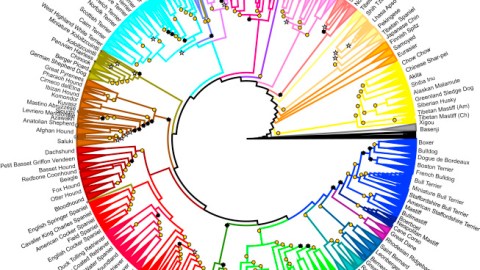New Genetic Study Shows the Origin of Dog Breeds

If asked outright, most American dog owners would say their loving pooch is a part of the family. Perhaps it’s the long history of interaction between our two species that makes us so close. Dogs and humans have been living together for at least 15,000 years.
There seems no end to the litany of breeds, 400 at last count. Though varying in size, shape, color, and coat dramatically, all breeds of dogs (Canis lupus familiaris) originate from one common ancestor, considered the gray wolf (Canis lupus). What happened was, people domesticated then bred them over time selectively, for different traits. The desired traits changed over the years, and this resulted in different breeds.
Now, a team of researchers has assembled the most comprehensive genomic map on dogs to date. The results were published in the journal Cell Reports. Researchers gathered blood samples or mouth scrapings from 1,346 dogs, of 161 breeds, over the course of 20 years. The dogs came from Europe, North America, Africa, and Asia.
Turns out, dogs were bred into certain types or “clades.” There are 23 in all. As humans migrated to different places, dogs went with them, even into the Americas across the Bering Strait. Today, all the dogs that we know of in North America originated in Europe. The European breeds superseded the original ones or interbred with them.

The 23 clades or types of dogs. Cell Reports.
Heidi Parker was the co-author of this study. She’s a geneticist and works at the National Institutes of Health (NIH). Parker said in a statement, “First, there was selection for a type, like herders or pointers, and then there was admixture to get certain physical traits.” What’s interesting is that breeding dogs for particular traits seemed to have popped up in multiple places at once. For instance, with the advent of agriculture, humans in multiple places in the world employed dogs for herding and guarding livestock.
The authors write another example in the study:
When dog fighting was a popular form of entertainment, many combinations of terriers and mastiff or bully-type breeds were crossed to create dogs that would excel in that sport. In this analysis, all of the bull and terrier crosses map to the terriers of Ireland and date to 1860–1870. This coincides perfectly with the historical descriptions that, though they do not clearly identify all breeds involved, report the popularity of dog contests in Ireland…during this era of breed creation.

Dog breeds and how they’re interrelated. Cell Reports.
Later on, dogs were bred for really specific tasks. Golden Retrievers, Irish Setters, and other “gun dogs,” can be traced back to Victorian England. With developments in firearm technology came these breeds best suited as the huntsman’s retriever, helper, and companion.
There are still a lot of unknowns when it comes to dogs, including how early humans came to domesticate gray wolves, why the first separate breed popped up, what it was, and why dogs continued to evolve into the wide variety we see today. Unraveling how dogs have evolved will help us learn our own history and give us clues into our evolution.
Researchers say with future studies, we’ll learn the origins of the diseases modern-day dogs’ experience. Their genomic data may offer clues to novel treatment options. And since the dog is a good model for diseases that affect humans, understanding what genes they have that fight disease will help us learn more about diseases that affect us too.
To hear what Bill Nye has to say about dog evolution, click here:





